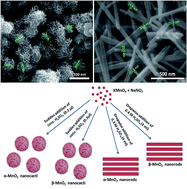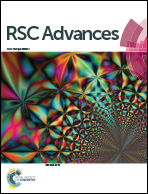Morphology and phase tuning of α- and β-MnO2 nanocacti evolved at varying modes of acid count for their well-coordinated energy storage and visible-light-driven photocatalytic behaviour
Abstract
A simple hydrothermal method is developed to synthesize two different phases, α and β of MnO2 nanocacti (comprising nanowires with 1–10 nm diameter self assembled by ultrathin sheets) as well as MnO2 nanorods (10–40 nm diameter) without any seed or template. Sudden addition of concentrated H2SO4 (0.3–0.4 μL) results in the formation of nanocacti while gradual addition (dropwise) of H2SO4 solution (0.3–0.4 M) results in nanorods. Besides, the α phase of MnO2 exists at relatively high acidic strength (4 pH) compared to the β phase, which is consistent at 5 pH. Thus this could be the first report exploring the possibilities of tuning morphology as well as the phase of MnO2 through simple optimizations in acidic content. We find that polymorphic MnO2 nanocacti exhibit superior photocatalytic activity and high energy capacity as an anode in Li-ion batteries than polymorphic MnO2 nanorods. The α phase of MnO2 performs better than the β phase. α-MnO2 nanocacti demonstrate high visible light driven photocatalytic activity by degrading >90% of congo red and methyl orange dyes in 40 mg L−1 organic dye aqueous solution with 0.1 g of the as-prepared sample within 25 and 70 min, respectively. We highlight the differences between the photocatalytic activities of different phases, α and β of MnO2 nanostructures, depending on the charge transport through different dimensions of the same pristine MnO2. The constant cycling stability of α-MnO2 nanocacti with capacities as low as 300 mA h g−1 at 1C rate after 50 cycles as an anode makes it a promising material for energy storage applications. We attribute the high electro- and photo-chemical activity for α-MnO2 nanocacti to their highly mesoporous structure making this one of the highest specific surface areas (271 m2 g−1) possibly ever reported for pristine MnO2.



 Please wait while we load your content...
Please wait while we load your content...